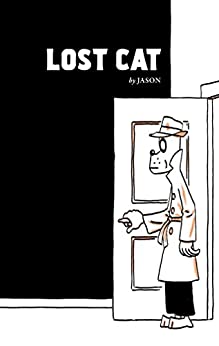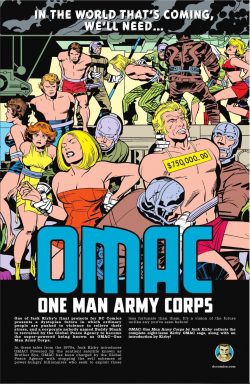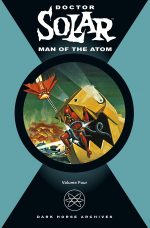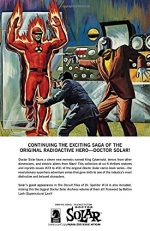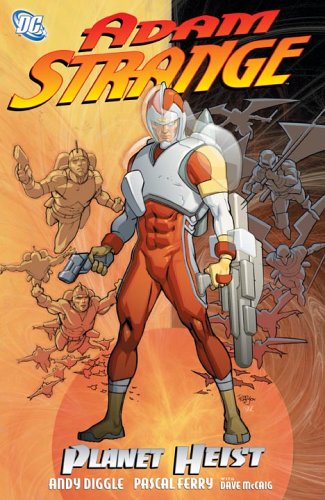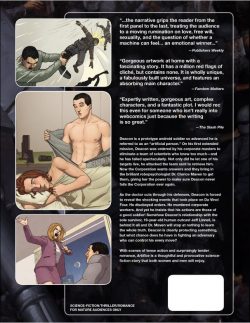
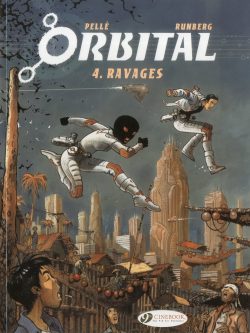
By Serge Pellé & Sylvain Runberg, translated by Jerome Saincantin (Cinebook)
ISBN: 978-1-84918-080-1 & 978-1-84918-088-7 (Album PBs/Digital Editions)
French science fiction always delivers amazing style and panache even when the underlying premise might be less than original. In Serge Pellé & Sylvain Runberg’s beautiful Orbital sequence, an initially-mismatched pair of Diplomatic Peacekeeper agents are deployed to quell incipient brushfire wars and mediate internal pressures within a vast pan-species intergalactic alliance, but the hoary “buddy-movie” format is a mere skeleton for eye-popping missions, star-spanning intrigue and intense personal interactions. These are always handled with deft wit and great imagination, never failing to carry the reader along in a blaze of fantastic fun…
What you need to know: after decades of pariah-status and intergalactic exclusion, Earth in the 23rd century has finally been allowed to join a vast Confederation of interstellar civilisations, despite grave and abiding concerns about humanity’s aggressive nature and xenophobic tendencies.
A militant “Isolationist” faction on Earth had moved from politics to horrific terrorism in the immediate run-up to humanity’s formal induction: committing atrocities both on Earth and far distant worlds where mankind had developed colonies and mining bases thanks to misused Confederation technology. Ultimately, the “Isos” failed to prevent our species’ inclusion in the pan-galactic union.
One particular and abiding Confederation concern was the way humans had treated the ancient alien civilisation of the Sandjarrs, whose world was previously invaded in Earth’s all-consuming drive for territory and exploitable resources. Subsequent human atrocities almost exterminated the stoic, pacifistic desert creatures…
Interworld Diplomatic Office operatives are assigned in pairs to troubleshoot throughout the stars, defusing crises before they become flashpoints of violence. IDO’s first human recruit Caleb Swany had been controversially teamed with Sandjarr Mezoke Izzua: a situation clearly designed as a high-profile political stunt, as was their initial mission: convincing an Earth mining colony to surrender a profitable planetary mining industry back to the aliens who actually own the moon Senestem it was situated on…
Moreover, even though Earth is a now a Confederation member, with humans well-placed in all branches of interstellar service, the Isolationist cause is still deeply cherished by many, needing only the slightest spark to reignite…
Nomades was originally released continentally in 2009, and as third translated Cinebook album Orbital: Nomads (2011) picks up soon after Caleb and Mezoke’s hard-won, brutally pragmatic solution was implemented. The Galactic Great-and-Good have since voyaged to Earth to very publicly celebrate and affirm the end of Human/Sandjarr hostilities in a series of spectacular Reconciliation Ceremonies, but the political glad-handing looks to be upstaged by another interspecies crisis…
One of the greatest benefits of induction into The Confederation has been the infusion of alien technologies which have cleansed and reinvigorated the ecosystem of long-abused and much-polluted Earth. Now however, an incident occurs in the newly restocked, again-abundant seas and mangrove swamps around Malaysia. The inexplicable death of millions of cloned and released sea species leads to a bloody clash between local human fishermen and an previously-unsuspected enclave of nomadic space-gypsies: The Rapakhun…
In Kuala Lumpur, Caleb is reminiscing with his old mentor Hector Ulrich – instrumental in brokering Earth into the Confederation and Swany into the Interworld Diplomatic Office – when news arrives of the trouble.
This will be tricky: much of mankind is still passively anti-alien, and local economies are fragile, whilst the Rapakhun are apparently no innocent angels. Many stellar civilisations despise them as shiftless, flighty wanderers who go where they please, refusing to be represented in or on Confederation Councils. Worst of all, they practice cannibalism…
By the time Caleb and Mezoke arrive on scene, events have escalated and tensions heightened to fever pitch, with a committee of human fishermen facing off against Rapakhun spokeswoman Alkuun.
The unwanted ancient tries to explain that the problem was simply an escaped Elokarn. The wanderers’ gigantic domesticated aquatic beasts have all been excessively agitated since arriving on Earth…
With the Diplomatic Agents assuring all parties that tests are underway to ascertain not only why the Elokarn went crazy but also why fish are dying off again, the situation seems contained, but when Alkuun invites the human guests to join in their holy consumption of a still-living and eager Rapakhun male, all the attendant peacemakers are physically revolted. Once seen, no amount of explanation that the willing, deeply spiritual and hugely prestigious sacrifice is meant to strengthen and invigorate the life force of Earth can offset that grisly sight…
Returning to Kuala Lumpur, Mezoke and Caleb are anxious. Although the Malaysian Navy are policing the area, the IDO agents know full well the tenuous trust humans place in any alien species, but their attention is unfortunately diverted by the sudden arrival of Caleb’s old friend Lukas Vesely.
The scrawny teen of his youth has become a hulking, good-natured member of Ulrich’s security force who seems very keen to relive the good old days. Caleb’s memories, however, can’t get past what he, little sister Kristina and Lukas used to do as teen vigilantes in Prague, mercilessly wreaking misguided vengeance upon isolationists like the ones who assassinated the Swany’s parents. In Caleb’s head, it’s just like yesterday…
In the mangrove swamps, fish are still dying, and now so are plants. When another group of fisherman get too close to the agreed-upon neutral zone, Ulrich’s forces overreact and the intruders perish, an event twisted by certain members of the outraged Malaysian Navy observers…
Despite and because of the distracting presence of Confederate supremo Evona Toot, Caleb and Mezoke are fully occupied as the delegation of Sandjarr dignitaries arrive. With a hungry pack of journalists eager to build and detonate a media-storm, the DA’s must navigate and manage the aloof, stand-offish guests of honour even though they somehow provoke fellow Sandjarr Mezoke to surly silence…
Soon, grim reports from Senestem take the shine off the supposed triumphant solution, while test results from the swamps all prove inconclusive. No contamination of any sort killed the wildlife: the culprit is some unknown form of energy…
Over gender-opaque Mezoke’s objections, Caleb seeks to downplay and even suppress the concatenation of bad news to keep the Reconciliation Ceremonies alive, until she/he/it/they reveals a shocking truth about the Sandjarr’s status prior to joining IDO…
Reports of human deaths are leaked to the populace and a “patriotic” clique in the Navy colludes to look the other way if any fishermen feel like dealing with the nomads once and for all…
By the time the IDO agents react to another human incursion, appalling bloodshed has ceased and – wading through a site of unspeakable carnage – Caleb and Mezuke decide to split up. The rapidly destabilising situation on Earth must be carefully managed, but most important is urgently sending an investigation team to the Rapakhun’s stopover world to learn exactly what the wanderers are capable of…
To Be Continued…
Fast-paced, action-packed, gritty space-opera with delightfully complex sub-plots fuelled by political intrigue and infighting elevates this tale to lofty and exotic heights, confirming Orbital as a series well worth your time and attention…
Ravages (Orbital volume 4) sees mismatched Diplomatic Peacekeeper agents conclude the sinister saga begun in Orbital: Nomads: subtly tweaking and deftly twisting a cunning skein of far-flung, futuristic political intrigue as the situation devolves into a full-on horror story of relentless alien terror…
Released in France in 2010, Orbital: Ravages is the fourth translated Cinebook album, picking up as Caleb and Mezoke flounder whilst a simple but tedious state function rapidly becomes an interspecies crisis…
The Galactic glitterati are on Earth to confirm the end of Human/Sandjarr hostilities in spectacular Reconciliation Ceremonies, but the cosmic bigwigs are only really concerned with how their precious Reconciliation plays out on their own worlds. The political glad-handing looked likely to implode after Kuala Lumpur’s human fisherman clashed with a hitherto unsuspected enclave of Rapakhun: cannibalistic space gypsies…
Confederation’s technologies had cleansed and reinvigorated Earth’s gravely wounded, ecosystem, but the restocked, seas and swamps around Malaysia are suddenly blighted by the mass extinction of millions of valuable fish. Humans blame the uninvited aliens, demanding the ODI Agents forcefully intervene. Swany and Mezoke swiftly comply, promising the truth will be found and shared.
This might be tricky: much of mankind remains staunchly anti-alien, local economies are fragile and the Rapakhun’s bad reputation across Confederation space might not be simple prejudice…
With the Agents occupied babysitting the Sandjarr delegation, fish and fisherman continue to die and the Malaysian Navy can no longer be trusted. As Caleb downplays – and even tries to suppress – bad news in hope of keeping the Ceremonies alive, the situation provokes a “patriotic” Navy clique to look the other way when locals try to deal with the nomads once and for all…
Riots and bloodshed erupt and the IDO operatives realise they must know more about the Rapakhun: someone has to visit their last port of call and see what they are really capable of…
The saga resumes in Kuala Lumpur’s grimily cosmopolitan Shah Alam district where human and alien scrap-merchants work side by side, salvaging materials and tech from junked starships. As tensions rise everywhere, one greedy toiler makes a grisly discovery and dies horribly in exactly the same manner as the fishermen in the distant swamps…
Caleb – over Mezoke’s protests – is in full-spin-control mode; weaving a pack of placatory lies to the journalists of uncounted watching worlds. Unable to leave Earth mid-crisis, the IDO agents recruited enigmatic human star-pilot Nina and her secretly-sentient Neuronome ship Angus to canvas distant world Dehadato, last refuge of the Rapakhun. Before they can report back a vast riot breaks out in Shah Alam…
The Fishermen’s Quarter is ablaze, a war-zone exploding with scared and angry humans and aliens, but when Caleb, Mezoke and Hector Ulrich overfly the scene of chaos and looting, they are brought down by rioters and must fight their way out…
Thanks to IDO intervention, canny bargaining, judicious bribery by city officials and an unlikely detente between the extraterrestrial scrap merchants and the ambitious new spokesman of the Fisherman’s Federation, the situation is soon damped down and all sides again tensely wait for answers…
On Dehadato, Nina and Angus explore the Rapakhun’s last campsite, uncovering scenes of horrific devastation, even as in Kuala Lumpur, Confederation leaders – terrified the situation is becoming politically untenable – consider cutting their losses and cancelling the Ceremonies…
It takes all Caleb’s strident persuasiveness to convince them – and Mezoke – to continue the itinerary of events. However, he gets a first inkling that they might be right when he’s informed a body has been found in the city, killed in the same extreme and inexplicable manner as the various swamp casualties…
On Dehadato, Nina and Angus rescue a poacher from the folly of his actions in pursuing monstrous, colossal and officially-protected Nargovals. As the Sülfir recovers, he imparts snippets of information about the Rapakhun and an incredible beast which infested the planet before the stellar nomads left. The doughty hunter only tried for the unstoppable leviathans which killed his entire poaching team after first ensuring there were no more Varosash on Dehadato, so the primordial predator must have departed with the gypsy cannibals…
Caleb has already concluded the Rapakhun are behind his problems, but as he stalks them through the swamps, word comes from Nina that he’s wrong, and it’s probably already be too late for the planet…
At Kuala Lumpur’s biggest sports arena, thousands of avid Speedball fans – human and otherwise – are packed together; reaching a fever pitch of excitement and unaware a hideous invisible killer – the very essence of all mankind’s fear of alien monsters – is ready to consume them all. Can disunited Caleb and Mezoke and their pitifully few allies destroy the invisible rapacious threat before it ends humanity? Or maybe there’s is hope as Nina and the Sülfir think they have a plan. Risky and probably fatal, but a plan nonetheless…
Fast-paced, action-packed, gritty and spectacular, Ravages offers pure high-octane space-opera, with deliciously complex sub-plots fuelled by political intrigue and a vast unexplored canvas tantalising readers at very moment.
One of the most beguiling sci fi strips of all time, Orbital is a delight every fan of the future should indulge in…
Original editions © Dupuis 2009, 2010 by Runberg & Pellé. All rights reserved. These editions published 2011 by Cinebook Ltd.



